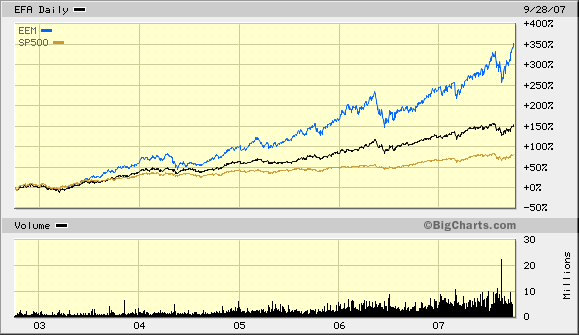During the previous bull market (10/02-10/07), financial media fawned over the critical importance of diversifying one’s equity exposure across the globe. And why not? Performance for foreign exchange-traded trackers like iShares MSCI EAFE (EFA) and iShares MSCI Emerging Markets (EEM) far surpassed anything the S&P 500 could muster up; developed international markets doubled U.S. capital appreciation while emerging economies catapulted 350%!

Indeed, when I spoke at conferences 10 years ago, attendees rarely inquired about companies listed on the Nasdaq or the New York Stock Exchange (NYSE). They wanted to know if they should add a materials exporting giant like iShares South Africa (EZA) to their portfolios or whether or not iShares Small Cap Brazil (BRF) would be a sensible way to tap consumer purchasing power in Latin America. Accessing overseas markets dominated speaker presentations as well as listener curiosity.
In 2000, the financial planning community typically rallied around a 20% equity allocation to foreign stock. By 2007, the 20% recommendation jumped to 50%. The reason? Well-diversified investors were supposed to account for the world’s market capitalization, where one-half of the world’s market cap belonged to non-U.S. securities.
So what happened to the notion of a globally diversified portfolio? Worldly investor perspectives? Could it be that, since the euro-zone crisis in 2011, U.S. stocks have crushed foreign equities? Maybe it is easier for CNBC and Bloomberg to praise U.S. stock price gains while ignoring bearish price depreciation in foreign equity holdings – significant positions in the static allocation of the buy-n-hold viewership.

Mainstream financial commentators may choose to focus on the progress of the S&P 500 alone. They may choose to ignore corrective activity in small caps via the Russell 2000, high yield bonds via SPDR S&P High Yield Corporate (JNK) and transporters via the Dow Jones Transportation Average. Yet ignoring bearishness in asset prices around the world is particularly near-sighted, if for no other reason that global economic weakness is the biggest threat to the worldwide profits and the worldwide revenue of large U.S.-based corporations.













Leave A Comment